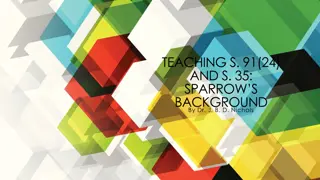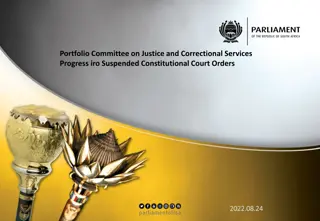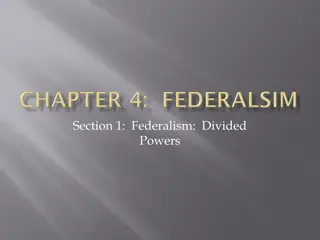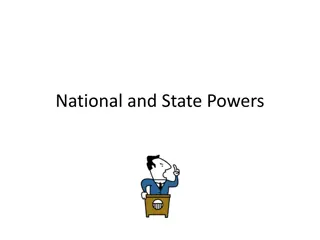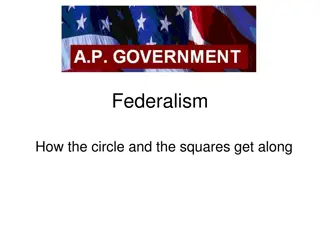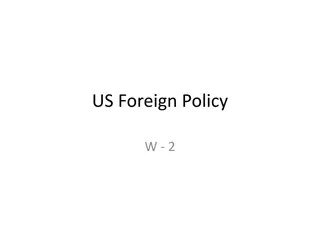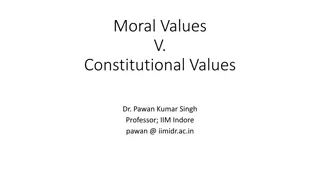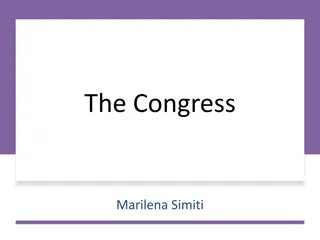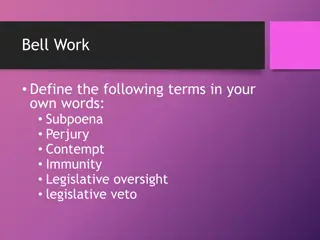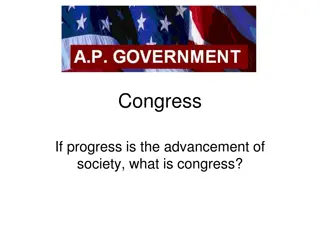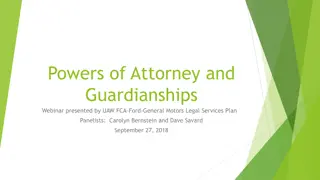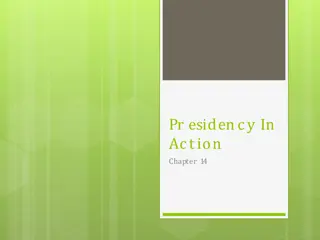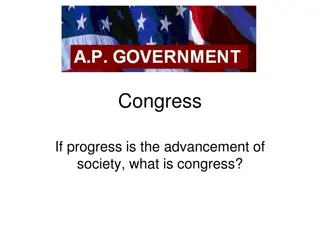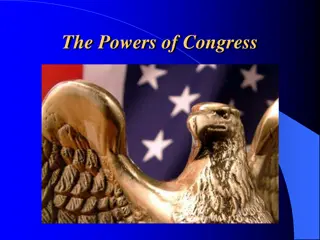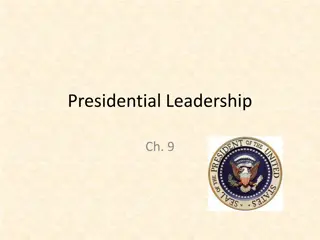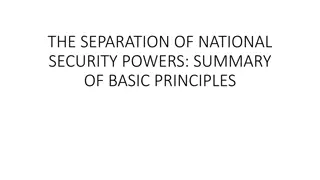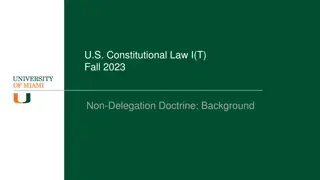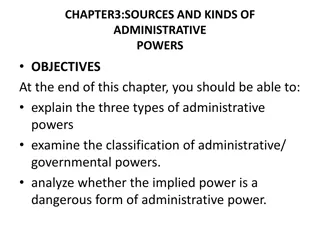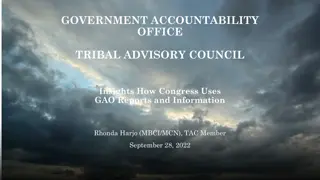Powers of Congress and Constitutional Framework
The powers of Congress in the United States are shaped and limited by two fundamental facts: limited government and a federal system. The Constitution grants Congress powers through expressed, implied, and inherent powers. The Congressional view of power varies between strict constructionists and liberal constructionists. Expressed powers from the Constitution include the power to tax, borrow, coin money, declare war, and exercise judicial powers. Implied powers originate from the Necessary and Proper Clause, allowing Congress to make laws necessary for executing its expressed powers.
Download Presentation

Please find below an Image/Link to download the presentation.
The content on the website is provided AS IS for your information and personal use only. It may not be sold, licensed, or shared on other websites without obtaining consent from the author. Download presentation by click this link. If you encounter any issues during the download, it is possible that the publisher has removed the file from their server.
E N D
Presentation Transcript
Powers of Congress Chapter 11
Powers Two fundamental facts shape and limit the powers of Congress: 1) Government in the United States is limited government. 2) The American system of government is federal in form. Federal = Government divided between national and local.
Constitutional Powers The Constitution grants Congress certain powers in three ways: 1) Expressed Powers Explicit, specifically worded. 2) Implied Powers Reasonably suggested. 3) Inherent Powers Automatically presumed.
Congressional View of Power 1) Strict Constructionist Congress should only be able to exercise the expressed powers and the implied powers that are necessary to carry out the expressed powers. 2) Liberal Constructionists Adopt a liberal interpretation that would give a broad application of powers given to Congress.
Expressed Powers From Article I, Section 8 of the Constitution Congress is given 27 explicit powers. Because the wording of these powers is brief, the actions taken by Congress define the laws. a) Supreme Court cases decide if actions of Congress are Constitutional. b) Many laws are still being defined today.
Five Expressed Powers 1) Power to Tax A charge levied by the government on people or property to raise money for public needs. 2) Power to Borrow The federal government many times spends more than it takes in and so must borrow money to make up the difference (Deficit Spending). 3) Power to Coin Money and regulate its Value The United States government can issue any thing it considers legal tender.
Five Expressed Powers Cont. 4) War Powers Only Congress can declare war, raise, and support a military. The President can call up the military but must inform Congress. 5) Judicial Powers Congress has the power to create and structure all courts below the Supreme Court. The Constitution creates the Supreme Court.
Implied Powers The implied powers given to Congress originate in the Necessary and proper Clause: Congress can make all laws which shall be necessary and proper for carrying into execution their expressed powers. McCulloch v. Maryland Landmark case in which the Supreme Court upheld the concept of implied powers for Congress.
Non-Legislative Powers Non-legislative powers are powers given to Congress that have nothing to do with lawmaking, but still have to be done by Congress. a) Electoral Duties If no presidential candidate receives a majority of electoral votes, the House of Representatives must vote for President. b) Impeachment Proceedings Only the House of Representatives can impeach. Only the Senate can hold an impeachment trial. c) Executive Powers Congress has the power to confirm any appointee made by the President (Cabinet members, Federal Marshall, Supreme Court)
Congress in Action Chapter 12
Presiding Officers The Constitution provides for the top officers in each chamber of Congress: Senate The Vice President serves as the President of the Senate. 11
Presiding Officers Cont. The Speaker of the House is the presiding officer in the House of Representatives. 12
Other Officers President Pro Temp This man serves as the presiding officer in the Senate when the Vice President is absent. He is 4th in line to the presidency. Each Party has a floor leader and an assistant floor leader called the whip. 13
How a Bill Becomes a Law The process of a Bill becoming a Law in the House of Representatives. A Bill is a proposed law presented to Congress for consideration. In the House of Representatives only a member can introduce a Bill. The first step is the member must put the Bill into the Hopper. 14
Types of Bills There are two types of Bills: 1) Public Bill Applies to the nation as a whole. 2) Private Bill Applies to a certain person or place. Sometimes a rider is attached to a Bill. Rider A provision not likely to pass on its own merit. 15
Process Cont. The Clerk of the House numbers each Bill as it is introduced. (H.R. 1) All Bills are printed and distributed their introduction. The Speaker of the House then sends each Bill to a standing committee. Standing committees act as a filter, rejecting unworthy Bills. Most committees do their work through subcommittees. after 16
Process Cont. Once debates in committees are done, there are 5 options for the Bill: 1) Pass it to the floor for debate. 2) Refuse to report on the Bill (Bill dies). 3) Report the Bill in amended form. 4) Report a Bill with unfavorable recommendation. 5) Report a Committee Bill (New Bill substituted for the old Bill). 17
Process Cont. Once a Bill makes it out of committee, it then is put on a calendar. At this point the Rules Committee sets a time for the Bill to be heard on Once the Bill reaches the floor 2 things happen: 1) Minor Bills are quickly voted on. 2) Major Bills go before the Committee of the Whole. the floor. 18
Committee of the Whole Committee of the Whole acts just as a large committee would. Only 100 members of the House need to be present. They will debate the entire Bill. When the Committee of the Whole is finished with its work, the Bill then goes before the entire House for debate. 19
Process Cont. Debates are much shorter in the House than in the Senate Senate can filibuster. Filibuster = The attempt to talk a death. Once a member calls for a vote in the House, debate must end, and a vote must take place. Bill to 20
The Vote The House uses four methods for taking votes: 1) Voice Votes Ayes and Nays. 2) Standing Vote Instead of saying yes or no, members stand for yes and no. 3) Teller Vote Each Party counts their own members. 4) Roll Call Vote Each individual is called upon to vote. 21
Senate Process Once a Bill has passed the House of Representatives, it then goes on to the Senate. The basic steps for passing a Bill in the Senate are nearly the same as in the House. Major difference is in the debate phase House debates are limited, Senate debates are unlimited. Cloture = A rule to limit a debate. 22
Conference Committee If a Bill does not pass through Senate committees exactly the same as it passed through the House, then the Bill is sent to a Conference Committee. Conference Committee A committee made up of members of each house. When the Bill passes through the Conference Committee, it is sent to both houses for a vote. 23
Bill Passes After a Bill has passed through the Senate unchanged it must be presented to the President. The President has four options for the Bill: 1) Sign the Bill into Law. 2) Veto the Bill (Congress can override a veto with a 2/3 majority vote in both houses). 24
Presidents Options Cont. 3) The President can do nothing and after 10 days it automatically becomes law (Congress must be in session). 4) Pocket Veto President can do nothing and Congress adjourns within 10 days, Bill dies. 25




